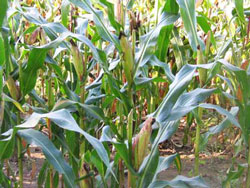WAITING
FOR EXPO 2015
![]() By Enza
Bettelli
By Enza
Bettelli
Provolone Valpadana DOP
The area of production of this typical cheese is spread over quite a vast
territory, over 4 regions in the Po valley, i.e. Piacenza in Emilia Romagna,
Trento in Trentino Alto Adige - in fact, provolone in the Venetian region
is made in the provinces of Verona, Vicenza, Padua and Rovigo - and, naturally,
in Lombardy in the provinces of Bergamo, Brescia, Cremona, Lodi and Mantua.
The territory is fascinating, including very beautiful landscapes together
with palaces and museums which are real architectural gems, in the midst
of natural parks and industrial areas of the Po Valley. There is a natural
abundance of green spaces and water courses which have been supplemented
by a network of man-made canals; these have enhanced cattle breeding
and milk and cheese production in a territory which was once unhealthy
but has been salvaged over the centuries by a lot of reclamation work,
the first of which go back to the Etruscan era.

THE CONSORTIUM
Provolone Valpadana obtained recognition of Denominazione di Origine Protetta
DOP (protected denomination of origin) in 1996; the consortium for
protection was formed in 1975 and is based in Cremona; at present, it
consists of about a dozen producers. At the end of November 2010
a new regulation for production was brought out; it prohibits the
food preservative E239. A further production guarantee is traceability
through the study of the DNA of each piece which means a profile
for each cheese producer can be defined. All pieces of provolone approved
by the consortium receive a three coloured rosette. Although the Po Valley
Provolone is sold to consumers at various weights, each packaging
must have a DOP label, an identification mark and an authorization
number from the Consortium for the Protection of Provolone Valpadana.

PROVOLONE AND DOP
Provolone Valpadana is a semi-hard cheese of a stringy consistency made
from whole cow milk with natural acidity from fermentation, in more
different sizes and forms (sausage, melon/pear, cone shaped, pear
shaped) than any other type of cheese; it is shaped by hand or in
moulds. There are two types of Provolone Valpadana: mild and strong.
The mild one is made with calf rennet, is matured for 2 to 3 months
at the most and may be pasteurized. The strong one is made with
kid and/or lamb rennet and is matured from at least 3 months up
to more than a year and may be treated with heat. Sometimes the forms
are covered by a protective substance, (for example paraffin). In the
absence of a covering layer the crust is smooth, thin, light yellow
in colour, sometimes yellow-brownish.

The inside is generally straw yellow, compact, and may have a few
small holes and a light "peeling" inside the cheese with
short maturing, but with more evident peeling in more mature cheeses.
Flavour is delicate in cheeses matured up to three months; from
marked to hot in pieces which have matured for a longer period or
which have been made with either kid or lamb rennet or both.

GASTRONOMY OF THE TERRITORY
 We have to consider 4 regions, even though they are all part of
the same immense valley. Great use is made of risotto, prepared with various
recipes, polenta (made with corn or buckwheat), filled and fresh pasta.
In the Veneto region you will find a lot of fish, whereas meat -
pork as well as beef - is present in the whole Po Valley and is
used for boiled, stewed and roast recipes and for the most
typical dishes such as Milanese cutlet or marrowbone. There is also a
tradition to use less precious parts of beef such as offal; in fact
tripe is popular in the gastronomy of this vast territory, made savoury
with vegetables and pulses, in a savoury soup.
We have to consider 4 regions, even though they are all part of
the same immense valley. Great use is made of risotto, prepared with various
recipes, polenta (made with corn or buckwheat), filled and fresh pasta.
In the Veneto region you will find a lot of fish, whereas meat -
pork as well as beef - is present in the whole Po Valley and is
used for boiled, stewed and roast recipes and for the most
typical dishes such as Milanese cutlet or marrowbone. There is also a
tradition to use less precious parts of beef such as offal; in fact
tripe is popular in the gastronomy of this vast territory, made savoury
with vegetables and pulses, in a savoury soup.
(English translation by Gudrun Dalla Via)
![]()
![]() Back to Waiting for EXPO 2015
Back to Waiting for EXPO 2015